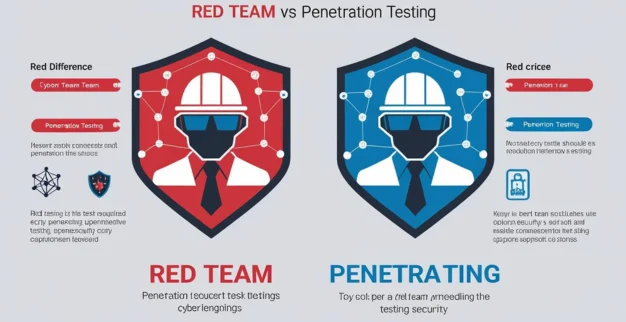Red Team Exercises Vs Penetration Testing. What's the difference?
By: Ganesan D
02 July 2025
Category: Penetration Testing
In the rapidly evolving technological world that we live in it is a constant struggle to keep
yourself and your organisation's resources secure. As the cyber security landscape expands, so do the security assessment procedures employed to best prepare against everchanging threats. Penetration testing and red team assessments have become the main way of testing the technical infrastructure and security resilience of an organisation. While both exercises contain common elements, they differ drastically in scope and approach.
Penetration Testing
A penetration test (PT) is a tool-assisted, manual security assessment designed to exploit vulnerabilities and evaluate how far an attacker could penetrate an organisation’s infrastructure. Penetration tests can be either goal-oriented (e.g. obtain access to sensitive data) or open-ended (aiming to uncover a broad range of issues).
Standard PTs focus on evaluating various attack surfaces—such as networks, systems, web applications, and mobile devices—to identify as many vulnerabilities as possible. Unlike red teaming, which emphasizes stealth and evasion, penetration tests typically occur with the knowledge of the organisation and its security team.
This transparency allows penetration testers to dedicate their full effort to vulnerability discovery without needing to navigate or bypass intrusion detection systems. As a result, PTs can often be "noisy", generating noticeable alerts, which is an acceptable trade-off for broader vulnerability coverage.
Red Team
A Red Team (RT) campaign is a threat-led security assessment that goes beyond traditional penetration testing by also evaluating an organisation’s detection and response capabilities—typically involving the Security Operations Centre (SOC), also known as the Blue Team. These campaigns are usually conducted covertly, with pre-agreed attack scenarios that simulate real-world threats.
Unlike penetration testing, which focuses on uncovering as many vulnerabilities as possible, red teaming is objective-driven. It aims to test how well an organisation can detect, respond to, and recover from targeted attacks. Due to its complexity and depth, red teaming is generally suited for organisations with mature cybersecurity frameworks.
Red teams want a stealthy way in and to remain undetected in the target's system for as long as possible, gleaning more and more information as they escalate throughout the company’s network. Because they’re after more sensitive data and have a longer time to acquire it, they work silently in the shadows so as to not be discovered, emulating an Advanced Persistent Threat (APT). Red team assessments begin with reconnaissance to collect as much information as possible about the target to learn about the people, technology and environment to build and acquire the right tools for the engagement. Using Open Source Intelligence Gathering, red teamers can gain a deeper understanding of infrastructure, facilities, and employees to better understand the target and its operations. This further enables weaponisation such as crafting custom malicious file payloads, prepping RFID (Radio Frequency Identification) cloners, configuring hardware trojans, or creating falsified personas/companies.
Execution of Red Teams
As part of the execution, red teamers will carry out actions on the target such as face-to-face social engineering or planting hardware trojans while noting any opportunities for exploitation.
In some instances, the more realistic threat scenario of red teaming is a superior testing modality. Red teaming places your organisation’s security team as close to a real security incident as possible, accurately testing incident response. At the end of a red team engagement, the blue team gives the red team any indicators of compromise (IoCs) that were detected during the engagement. This data can then be compared to other data collected during the course of the engagement and incorporated into a report timeline. To help draw value from the exercise, the red team works closely with the blue team to explain its Tactics, Techniques and Procedures (TTPs) and how to better detect and respond to such offensive methods in future incidents.
Penetration testers, on the other hand, are more geared towards identifying existing vulnerabilities, applying a more general or holistic approach to testing. This has the advantage of providing more bang for the buck, especially for an organisation with less security maturity. Identification and validation of vulnerabilities provides a clear snapshot of the existing threats, identifying potential business impacts that may result from successful exploitation.
Differentiation between Penetration Testing and Red Teaming
| Aspect |
Penetration Testing |
Red Teaming |
| 1. Time |
Shorter testing windows, from days to a few weeks typically. |
Several weeks and potentially more than a month. |
| 2. Objective |
Identifying all exploitable vulnerabilities such as missing patches, misconfigurations and user access management weaknesses to identify security risks to be remediated. Focus is on the systems and technology in place.
|
Accessing specific systems or data by exploiting vulnerabilities, behaviours and circumventing technical controls with the aim of testing detection, response and security awareness and culture. More of a holistic approach with more time for reconnaissance and a look at the entire organisation’s security practices.
|
| 3. Tactics |
Depending on the scope of the test – for example: external infrastructure, web application, mobile application and remote desktop breakout tests will follow different best practice methodologies and use different tools and techniques.
|
Combination of real-world tactics, tools and procedures including detailed open-source intelligence gathering, social engineering, distraction techniques, technical vulnerability identification and exploitation and data exfiltration all while making sure to remain undetected.
|
| 4. Outcome |
Identification of exploitable security vulnerabilities – assessed on their level of risk to the organisation – together with remediation advice and technical recommendations.
|
Provides insight into the overall security posture of the target organisation (covering strengths and weaknesses) including detection and response capabilities, logical and physical security, security awareness and culture. Includes recommendations for key issues identified.
|
| 5. Cost |
Usually cheaper, because a limited window for testing is agreed upon based on the client’s objectives and the available budget.
|
Usually more expensive, because more consultants are involved, and it takes longer using multiple tools and techniques to help avoid detection.
|



